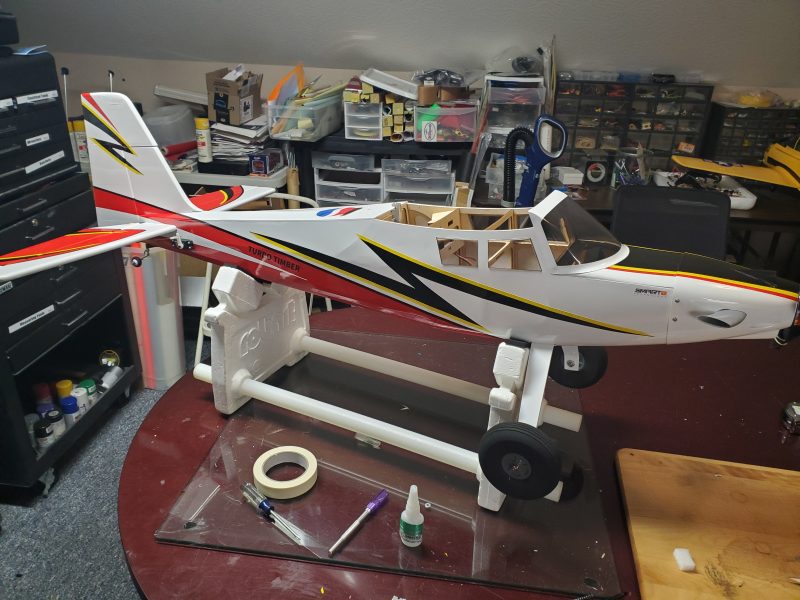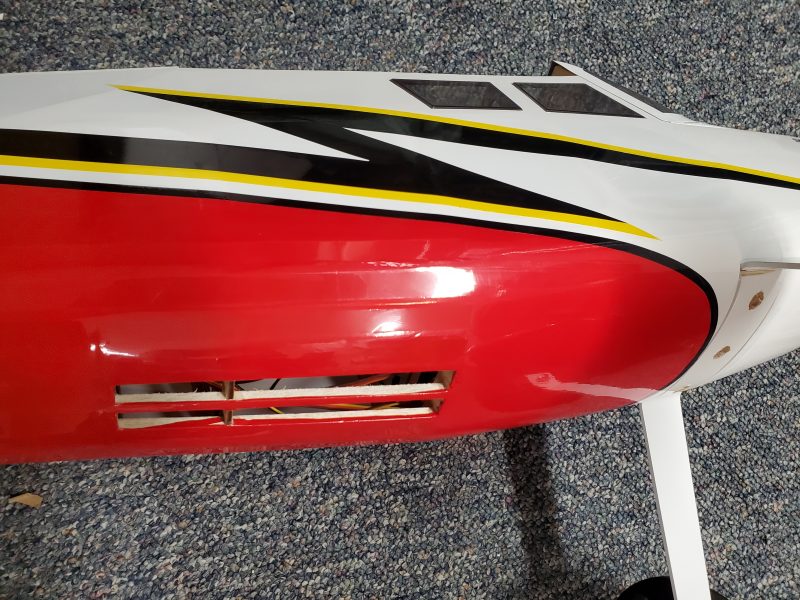Following the basic build/assembly I was able to get back to flying and tuning the TT to give me the performance I am most interested in. In my case, the last thing I care about is high speed. I’m interested in aerobatic capability, STOL performance and duration as much as possible with a bit of 3D capability thrown in… though I’m not a true 3D capable pilot.
Here are some of what I found and the adjustments I’ve made to get the most out of the airplane.
One thing I did early on was to change the color pallete a bit. I added some bright yellow pinstriping to give the plane a bit of individuality. I also used only a few of the supplied decals in a slghtly different pattern than the pictured model on the box. Just something to separate my airplane from any others that might appear on the flight line.
More pertinent to performance, I have made a few other changes, the first of which is to create some exit area for airflow through the airframe such that the ESC and battery get some cooling. In my case I opened up some of the spaces between longerons just aft of the bottom beacon LED. Air inflow is largely useless without a way for it to exit and can even create problems like hatches blowing off with positive pressure created behind them, etc… Ditto for any covering that becomes loose over time.
I also did quite a bit of flying with a few different prop sizes and types… though i could do some more. The provided prop is great. If it isn’t a Xoar beechwood, it is a very close copy and I have run both the original and a Xoar 15×8 and see no performance difference. I’ve also run a 15×6 and 16×6 APC-E. The 15×6 was adequate and dropped top end power and average current flow but the airplane just didn’t have the same punch… Ultimately I did not enjoy flying the aircraft with that prop. The 16×6 is my current favorite. It seems to draw just a little less current than the stock prop while giving even a bit more torque and giving up nothing other than just a tad of top end speed. Since I see no use for that anyway, I am spending my time flying with the 16×6.
Once I was happy with the prop I started expanding my flights to get all my throws, mixes, rates etc… dialed in. I’m getting close to having all that set to my satisfaction.
My latest big setup and tuning change was to take thrust reversing back out of the picture! I have had it in since the begining, and enjoyed doing some short landings and backing into the pit area. All good fun, but the biggest thing I was unhappy with was the downline speed of this aircraft. It just seemed like pointing the nose down was like dropping a concrete block. It made downline manuevers rushed and didn’t look the way I like to see an aircraft like this fly.
What I believe now is that the speed controller just doesn’t allow for the brake to be turned “off” whilst having reverse thrust enabled. While I always expected that letting the prop freewheel would result in some downline braking… I never realized how much! With the 16×6 prop providing a larger “disc” and the prop free wheeling… the airplane seems to really maintain a nice downline pace.
With that change, I have been happily exploring and practicing many of my favorite skills including smooth “tail up” takeoffs and landings, intermediate level IMAC style aerobatics, flap usage on landing and takeoffs, etc… I finally am flying the plane I always hoped it would be and have turned off some of my rates as I get things dialed in to the point that I no longer need them.
If I could turn braking on/off remotely, I’d certainly entertain having that available on landing and I am still tinkering with crow and full span flap useage but the main settings are fairly locked in at this point. Next up is likely to do some glider towing. Will have to see what I can do to get a good climb rate but limit forward speed to get the best tow flight profile! There’s always another challenge with a versatile aircraft like this one!
I’m looking forward to flying the Turbo Timber SWS for (hopefully) years to come. She looks to be a long term member of the hangar.



